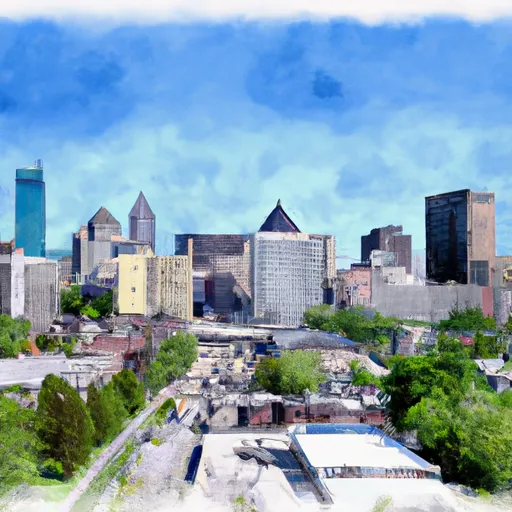-
 Snoflo Premium
Snoflo Premium
Get unlimited access to all our content
With no Ad interruptions! - Start Your Free Trial Login with existing account
Uptown
Eden Index
Climate
8.3
•
Recreation
2.8
•
Community
2.9
•
Safeguard
5.0/10

Uptown, Pennsylvania is a vibrant community located in the heart of the state. The town enjoys a temperate climate, experiencing warm summers and cool winters. Average high temperatures in the summer reach around 80°F (27°C) while winter lows can drop to around 25°F (-4°C). Rainfall is evenly distributed throughout the year, with an average annual precipitation of 40 inches (102 cm).
Hydrology plays a significant role in Uptown's landscape, as it is home to several rivers and streams. The Susquehanna River flows nearby, providing opportunities for boating, fishing, and other water activities. Additionally, Uptown is also known for its numerous lakes and reservoirs, offering further recreational possibilities like swimming, kayaking, and picnicking.
Outdoor enthusiasts will find a variety of activities to enjoy in Uptown. The surrounding area boasts numerous parks, hiking trails, and nature reserves, providing ample opportunities for walking, biking, and wildlife observation. In particular, the nearby State Forest offers extensive trails for hiking and camping, allowing visitors to immerse themselves in the beauty of the local flora and fauna.
Overall, Uptown, Pennsylvania offers a pleasant climate, abundant water resources, and diverse outdoor recreation opportunities, making it an ideal destination for nature lovers and adventure seekers.
What is the Eden Index?
The Snoflo Eden Index serves as a comprehensive rating system for regions, evaluating their desirability through a holistic assessment of climate health, outdoor recreation opportunities, and natural disaster risk, acknowledging the profound impact of these factors on livability and well-being.
Climate Health Indicator (CHI): 8.3
Uptown receives approximately
977mm of rain per year,
with humidity levels near 83%
and air temperatures averaging around
11°C.
Uptown has a plant hardyness factor of
6, meaning
plants and agriculture in this region thrive during a short period during spring and early summer. Most
plants will die off during the colder winter months.
By considering the ideal temperature range, reliable water supplies, clean air, and stable seasonal rain or snowpacks, the Climate Health Indicator (CHI) underscores the significance of a healthy climate as the foundation for quality living.
A healthy climate is paramount for ensuring a high quality of life and livability in a region, fostering both physical well-being and environmental harmony. This can be characterized by ideal temperatures, reliable access to water supplies, clean air, and consistent seasonal rain or snowpacks.
Weather Forecast
Streamflow Conditions
Allegheny
Area Rivers
Allegheny
Snowpack Depths
Allegheny
Reservoir Storage Capacity
Allegheny
Groundwater Levels
Recreational Opportunity Index (ROI): 2.8
The Recreational Opportunity Index (ROI) recognizes the value of outdoor recreational options, such as parks, hiking trails, camping sites, and fishing spots, while acknowledging that climate plays a pivotal role in ensuring the comfort and consistency of these experiences.
Access to outdoor recreational opportunities, encompassing activities such as parks, hiking, camping, and fishing, is crucial for overall well-being, and the climate plays a pivotal role in enabling and enhancing these experiences, ensuring that individuals can engage in nature-based activities comfortably and consistently.
Camping Areas
| Campground | Campsites | Reservations | Toilets | Showers | Elevation |
|---|---|---|---|---|---|
| Colonel Crawford County Park | 111 | 1,308 ft | |||
| Chestnut Ridge Regional Park | None | 2,268 ft | |||
| Tygart Lake State Park | None | 1,516 ft | |||
| Two Mile Run County Park | None | 1,304 ft | |||
| Coopers Rock State Forest | None | 2,154 ft | |||
| Mason - Dixon Historical Park | None | 1,170 ft |
Nearby Ski Areas
Catastrophe Safeguard Index (CSI):
The Catastrophe Safeguard Index (CSI) recognizes that natural disaster risk, encompassing floods, fires, hurricanes, and tornadoes, can drastically affect safety and the overall appeal of an area.
The level of natural disaster risk in a region significantly affects safety and the overall livability, with climate change amplifying these risks by potentially increasing the frequency and intensity of events like floods, fires, hurricanes, and tornadoes, thereby posing substantial challenges to community resilience and well-being.
Community Resilience Indicator (CRI): 2.9
The Community Resilience Indicator (CRI) recognizes that education, healthcare, and socioeconomics are crucial to the well-being of a region. The CRI acknowledges the profound impact of these elements on residents' overall quality of life. By evaluating educational resources, healthcare accessibility, and economic inclusivity, the index captures the essential aspects that contribute to a thriving community, fostering resident satisfaction, equity, and social cohesion.

